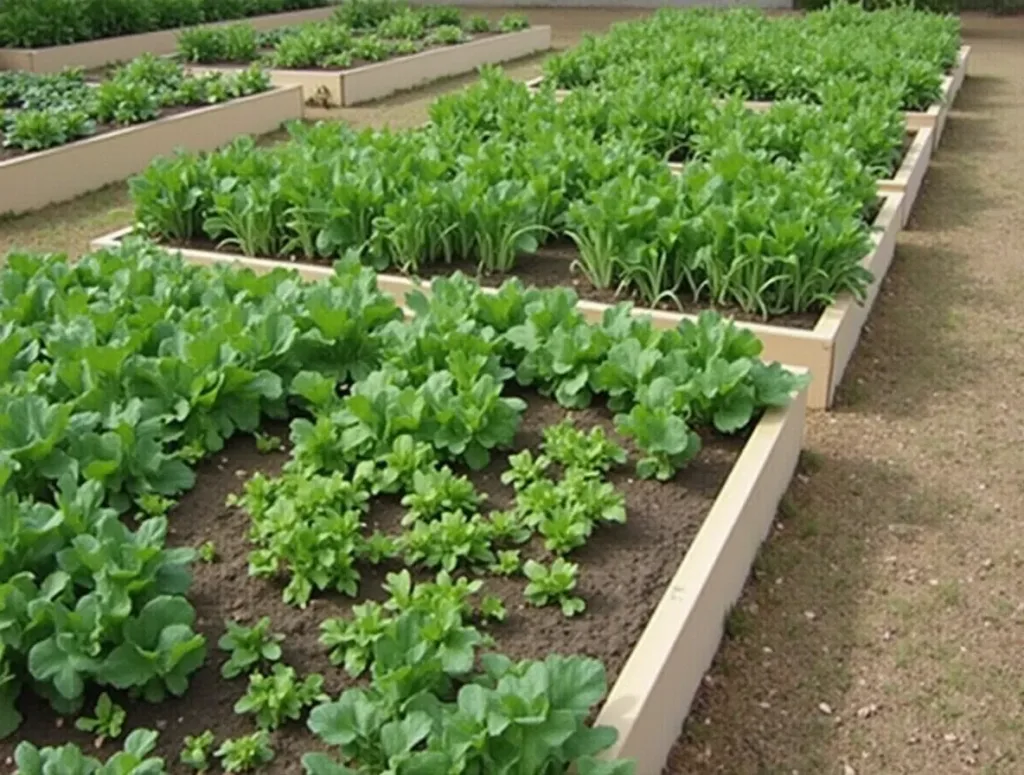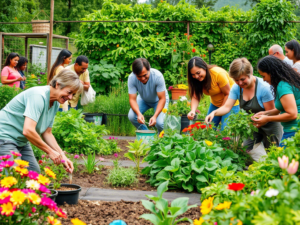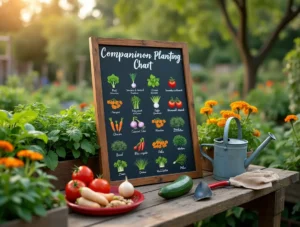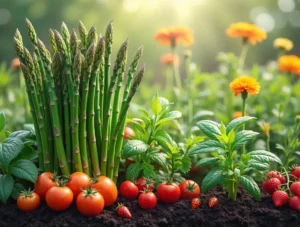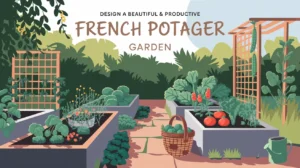Permaculture Garden: More Than a Garden—A Living Ecosystem
A Permaculture Garden is not just a place to grow food—it’s a vibrant, self-sustaining ecosystem where tomatoes climb alongside fragrant herbs, rainwater nourishes thirsty soil, and pollinators dance between sunflowers and lavender. Unlike traditional gardening, permaculture doesn’t fight nature; it collaborates with it, transforming barren patches or even balconies into resilient, regenerative spaces that benefit people, wildlife, and the planet.
Rooted in three core ethics—care for the Earth, care for people, and fair sharing of resources—permaculture gardens mimic natural ecosystems to create abundance with minimal waste. Whether you’re working with acres of land or a few pots on a patio, this guide will walk you through practical steps to design, plant, and nurture a garden that thrives on synergy, not synthetic inputs.
On This Page
Ready to ditch the grind of conventional gardening and join the quiet revolution of working with nature? Let’s begin.
Observe and Analyze Your Site
Permaculture begins not with digging, planting, or building—but with watching. Nature is the ultimate teacher, and your land already holds clues about how to design a thriving garden. Before you lift a shovel, invest time in observing and decoding your site’s unique language.
Think Holistically: See the Big Picture
Permaculture isn’t about isolated plants or patches—it’s about relationships. Ask yourself:
- Where does sunlight linger in winter? Where does water pool after rain?
- How do existing plants, insects, and animals interact?
- What resources (leaves, kitchen scraps, rainwater) are being wasted?
Example: A shady corner might seem “useless” for veggies, but it could become a mushroom-growing zone or a habitat for frogs that eat pests.
Know Your Climate: Work with Local Conditions
Your garden’s success hinges on understanding your regional climate:
- Hardiness Zone: Determine your USDA Zone (or equivalent) to choose cold- and heat-tolerant plants.
- Rainfall Patterns: Is your area prone to droughts or monsoons? Plan water storage accordingly.
- Frost Dates: Note first and last frost dates to time plantings (tools like Almanac’s Garden Planner can help).
Pro Tip: Chat with local gardeners or nurseries—they’re treasure troves of climate-specific wisdom.
3. Map Microclimates: Unlock Hidden Potential
Microclimates are small areas where conditions differ from the broader landscape. Identify:
- Sun Traps: South-facing walls or slopes that stay warmer.
- Wind Tunnels: Gaps between buildings or fences that amplify breezes.
- Cool Zones: Damp, shaded spots under trees or structures.
Example: A sun-warmed brick wall could extend your growing season for heat-loving crops like tomatoes.
4. Note Topography: Let the Land Shape Your Design
Slopes, valleys, and flat areas dictate water movement and plant placement:
- Slopes: Use swales (ditches along contours) to capture rainwater and prevent erosion.
- Low Spots: Ideal for rain gardens or water-loving plants like willows.
- Flat Ground: Perfect for vegetable beds or compost systems.
Action Step: Sketch a rough contour map of your site to visualize water flow.
5. Investigate Weeds: Decode Nature’s Messages
Weeds aren’t enemies—they’re indicators of soil health:
- Dandelions: Signal compacted soil (their deep roots break up hard earth).
- Clover: Suggests low nitrogen (it fixes nitrogen from the air).
- Plantain: Thrives in acidic, poorly drained soil.
What to Do:
- Remove invasives (e.g., bindweed) that harm ecosystems.
- Leave beneficial “weeds” like yarrow (attracts pollinators) or chickweed (edible ground cover).
Design with Zones and Sectors
With your site observations in hand, it’s time to translate insights into a functional design. Permaculture’s zoning system organizes your garden based on frequency of use and energy efficiency, ensuring every element—from compost bins to fruit trees—works in harmony.
1. Identify Zones of Use
Zones range from most-visited to least-disturbed areas:
- Zone 0: Your home (the hub of energy and resources).
- Zone 1: High-traffic, daily-use areas (herb spirals, salad beds, seating).
- Example: Plant mint and basil by the kitchen door for easy harvests.
- Zone 2: Perennials and small livestock (berries, chickens, beehives).
- Zone 3: Main crops (fruit trees, large vegetable patches).
- Zone 4: Semi-wild areas (timber trees, foraging zones).
- Zone 5: Wilderness (untouched to support biodiversity).
Pro Tip: Start small! Focus on Zones 1–2 first to build confidence before expanding.
2. Channel Water Strategically
Water is lifeblood in permaculture. Design systems to capture, store, and redistribute it:
- Swales: Dig shallow trenches along contours to slow runoff and hydrate soil.
- Rain Gardens: Plant water-loving species (e.g., elderberry, cattails) in low-lying areas.
- Ponds: Create wildlife habitats and emergency irrigation sources.
Example: A swale on a slope directs rainwater to thirsty fruit trees, reducing the need for watering.
3. Ensure Proper Access
Paths and access points prevent soil compaction and save energy:
- Main Paths: Wide enough for wheelbarrows (use wood chips or gravel).
- Secondary Paths: Narrow stepping stones through garden beds.
- Zone Connections: Position compost bins near Zone 1 and orchards near Zone 3.
Avoid: Placing heavy-traffic paths in delicate root zones (e.g., under fruit trees).
4. Place Structures Thoughtfully
Align buildings and infrastructure with zones and natural patterns:
- Compost Bins: Near Zone 1 for kitchen scrap convenience.
- Greenhouses: In sunny microclimates (e.g., south-facing slopes).
- Tool Sheds: Central to Zones 2–3 for easy access during harvests.
Bonus: Use structures as thermal mass! A stone shed can radiate heat to nearby plants on chilly nights.
Prepare the Soil
Healthy soil is the heartbeat of a permaculture garden. Unlike conventional gardening, which often relies on synthetic fertilizers, permaculture focuses on building living soil—teeming with microbes, fungi, and organic matter. This step ensures your plants thrive while reducing the need for constant inputs.
1. Test Soil Health: Know Your Starting Point
Before adding amendments, understand your soil’s baseline:
- pH Level: Most veggies prefer 6.0–7.0. Use a DIY test kit or send a sample to a lab.
- Too acidic? Add crushed limestone.
- Too alkaline? Mix in composted leaves or pine needles.
- Texture: Squeeze a handful of damp soil.
- Sandy (gritty, drains fast): Add compost to retain moisture.
- Clay (sticky, dense): Mix in coarse sand or biochar for aeration.
- Loam (crumbly and dark): Celebrate—it’s ideal!
Pro Tip: Check for earthworms—they’re nature’s soil engineers. No worms? Your soil needs organic love.
2. Build Fertility Naturally
Skip synthetic fertilizers. Feed your soil with these regenerative methods:
- Compost: Turn kitchen scraps, leaves, and grass clippings into “black gold.”
- Cover Crops: Plant clover, buckwheat, or vetch to suppress weeds and fix nitrogen.
- Mulch Layers: Apply straw, wood chips, or cardboard to protect soil and boost organic matter over time.
- No-Till Gardening: Avoid disrupting soil structure—plant directly into mulch or compost.
Example: A bed layered with compost, straw, and comfrey leaves becomes a self-fertilizing ecosystem.
3. Mulch Generously: The Permaculture Blanket
Mulch is a permaculture superpower:
- Retains Moisture: Reduces watering by up to 50%.
- Suppresses Weeds: Blocks light from weed seeds.
- Feeds Soil: Decomposes into nutrients over time.
What to Use:
- Straw: Ideal for veggie beds (avoids weed seeds).
- Wood Chips: Perfect for paths or around trees.
- Leaf Mold: Free and nutrient-rich (collect autumn leaves!).
Avoid: Plastic mulch—it kills soil life and creates waste.
Choose Plants and Create Guilds
In permaculture, plants aren’t just solitary actors—they’re team players. By selecting species that support one another and serve multiple roles, you’ll create a garden that’s resilient, productive, and alive with biodiversity. Let’s explore how to build plant communities that work together, not compete.
1. Select Multi-Functional Plants
Prioritize plants that offer more than one benefit to your garden:
- Food + Function:
- Comfrey: Deep roots mine nutrients for nearby plants; leaves make nutrient-rich compost tea.
- Lavender: Attracts pollinators and deters pests like aphids.
- Sunflowers: Provide shade for delicate crops, feed birds, and stabilize soil.
- Native and Perennial Powerhouses:
- Choose plants adapted to your region (e.g., elderberry, serviceberry, or native grasses).
- Perennials like asparagus, rhubarb, or fruit trees reduce replanting labor.
Pro Tip: Avoid invasive species! Check local guidelines (e.g., USDA’s invasive plant list).
2. Design Plant Guilds: Nature’s Dream Teams
A guild is a group of plants, animals, and fungi that support each other like a mini-ecosystem. Build around a central element (often a fruit tree):
- Classic Apple Tree Guild:
- Canopy: Apple tree (provides fruit and shade).
- Understory: Comfrey (nutrient accumulator), chives (pest deterrent).
- Ground Cover: Strawberries (suppress weeds, yield fruit).
- Roots: Garlic (repels pests, improves soil).
- Herb Spiral Guild:
- Stack sun-loving herbs (rosemary, thyme) at the top and moisture-loving mint at the base.
Rule of Thumb: Mimic forest layers—canopy, shrubs, herbs, ground cover, roots, and vines.
3. Diversify for Resilience
Monocultures invite pests and disease. Instead, mix it up:
- Polyculture Beds: Interplant veggies, flowers, and herbs (e.g., tomatoes + basil + marigolds).
- Succession Planting: Rotate crops seasonally (e.g., cool-weather peas → heat-loving beans → fall kale).
- Wild Edges: Leave space for “volunteer” plants (e.g., dill, borage) that self-seed and support wildlife.
Example: A bed with kale (food), calendula (pollinator magnet), and nasturtiums (trap crop for aphids) balances productivity and pest control.
Implement Water Systems
Water is the lifeblood of any garden, and in permaculture, it’s all about harnessing every drop wisely. By designing systems that capture, store, and distribute water efficiently, you’ll create a drought-resilient garden that thrives with minimal intervention. Let’s dive into strategies to turn rainwater into a resource, not a waste product.
1. Harvest Rainwater: Turn Skywater into Gold
- Rain Barrels: Install barrels under downspouts to collect roof runoff (1 inch of rain = 600 gallons per 1,000 sq. ft. of roof!).
- Bioswales: Plant shallow, vegetated ditches to slow and filter runoff while channeling it to gardens.
- Ponds and Hugelkultur:
- Dig small ponds to store water and attract wildlife.
- Build hugelkultur beds (mounded logs and organic matter) to retain moisture for years.
Pro Tip: Use first-flush diverters to keep debris out of rainwater tanks.
2. Use Efficient Irrigation: Water Smarter, Not Harder
- Drip Systems: Deliver water directly to plant roots with minimal evaporation (ideal for arid climates).
- Ollas: Bury unglazed clay pots filled with water—they’ll seep moisture slowly into the soil.
- Soaker Hoses: Lay porous hoses through garden beds for even, low-pressure watering.
Avoid: Overhead sprinklers—they waste water, promote disease, and encourage shallow roots.
3. Design for Natural Water Flow
Work with your site’s topography to guide water where it’s needed:
- Swales on Contours: Capture runoff on slopes and let it sink into the soil.
- Keyhole Beds: Shape beds in a keyhole pattern with a central compost basket that acts as a water reservoir.
- Redirect Roof Runoff: Channel gutter water to fruit trees, rain gardens, or thirsty crops like squash.
Example: A swale-fed apple tree guild stays hydrated even during dry spells.
4. Recycle Greywater (Safely!)
Repurpose water from showers, sinks, or washing machines (non-toxic soaps only!):
- Simple Systems: Use a bucket to collect shower warm-up water for trees.
- Advanced Systems: Install branched drain systems to irrigate non-edible plants like ornamental shrubs.
Caution: Avoid greywater on root crops (e.g., carrots) or edible greens to prevent contamination.
Start Small and Experiment
Permaculture isn’t about overhauling your entire yard overnight—it’s about starting where you are and growing with confidence. Begin with manageable projects, learn from trial and error, and let your garden evolve organically. Here’s how to avoid overwhelm and build momentum:
1. Begin with a Keyhole Bed or Container Garden
- Keyhole Beds: Circular raised beds with a compost basket at the center (feeds plants as it decomposes).
- Perfect for herbs, greens, and compact veggies.
- Container Gardens: Use pots, buckets, or repurposed items (e.g., bathtubs, pallet planters).
- Ideal for balconies or rented spaces.
- Easy Starter Plants:
- Leafy greens (kale, lettuce), herbs (basil, parsley), or radishes (fast-growing and forgiving).
Pro Tip: Place containers near your kitchen door for daily inspiration and easy care.
2. Track Progress: Learn by Doing
- Journaling: Note what works (e.g., “marigolds reduced aphids on tomatoes”) and what doesn’t (“zucchini drowned in clay soil”).
- Photo Diary: Snap monthly pics to observe growth patterns and microclimate changes.
- Ask Why: If a plant struggles, dig deeper—was it water, pests, or poor soil? Adjust accordingly.
Example: A failed squash crop might reveal the need for better drainage or companion planting.
3. Expand Gradually: Scale with Success
- Year 1: Focus on Zone 1 (kitchen garden) and soil-building.
- Year 2: Add a fruit tree guild or rainwater catchment system.
- Year 3+: Introduce livestock (e.g., chickens for pest control) or expand to Zone 3 crops.
Rule of Thumb: Only take on what you can maintain joyfully—permaculture should reduce stress, not add it!
Maintain and Adapt
A permaculture garden isn’t a “set it and forget it” project—it’s a living, evolving ecosystem. Regular care, observation, and flexibility ensure your garden stays resilient through seasons, pests, and climate shifts. Here’s how to nurture your garden for the long haul:
1. Observe and Adjust: Stay Curious
- Weekly Check-Ins: Note plant health, pest activity, and soil moisture.
- Seasonal Shifts:
- Spring: Plant summer crops, divide perennials, and refresh mulch.
- Summer: Harvest regularly, shade delicate plants, and manage water.
- Fall: Plant cover crops, collect seeds, and prep beds for winter.
- Winter: Prune dormant trees, plan next year’s design, and compost leaf litter.
- Respond to Challenges:
- Example: If slugs devour seedlings, add duckweed to ponds (ducks eat slugs) or copper tape around beds.
2. Foster Biodiversity: Build a Balanced Ecosystem
- Attract Beneficial Insects:
- Plant yarrow, dill, or fennel to lure ladybugs and parasitic wasps (natural pest control).
- Rotate Crops:
- Prevent soil depletion and pest cycles (e.g., follow tomatoes with beans to replenish nitrogen).
- Practice Polyculture:
- Mix flowers, herbs, and veggies to confuse pests and boost resilience.
Pro Tip: Leave some “wild” corners with fallen logs or native plants to shelter frogs, beetles, and birds.
3. Nourish Soil Continuously
- Top-Dress Beds: Add compost or worm castings each season.
- Plant Cover Crops: Clover, buckwheat, or winter rye protect soil and add organic matter.
- Avoid Disturbance: Stick to no-till methods to protect soil fungi and worm networks.
Example: After harvesting garlic, sow phacelia (a bee-friendly cover crop) to suppress weeds and feed soil.
4. Manage Pests Naturally
- Companion Planting:
- Marigolds repel nematodes; basil deters tomato hornworms.
- Physical Barriers:
- Use row covers for cabbage moths or netting for birds.
- Biological Controls:
- Introduce nematodes for grubs or chickens for slug patrol.
Avoid: Broad-spectrum pesticides—they harm pollinators and soil life.
5. Adapt to Change: Embrace Flexibility
- Climate Resilience:
- Plant drought-tolerant species (e.g., rosemary, agave) if dry spells increase.
- Build raised beds in flood-prone areas.
- Learn from Failure:
- Did a guild fail? Adjust plant pairings or soil conditions.
- Experiment Fearlessly:
- Try new techniques (e.g., mushroom logs, aquaponics) to keep the garden dynamic.
6. Engage the Community: Share the Journey
- Host Skill Shares: Teach neighbors to build compost bins or prune fruit trees.
- Create a Seed Library: Swap heirloom seeds to preserve genetic diversity.
- Celebrate Harvests: Host potlucks or donate surplus to food banks.
Engage with the Community
Permaculture isn’t just about nurturing plants—it’s about cultivating connections. A thriving garden becomes even more powerful when it’s woven into the fabric of community. By sharing knowledge, resources, and harvests, you’ll amplify your impact and inspire others to join the regenerative movement.
1. Share Surplus: Abundance Multiplies
- Seed and Plant Swaps: Host or attend events to exchange heirloom seeds, cuttings, or seedlings.
- Example: Trade your extra tomato starts for a neighbor’s rare pepper variety.
- Produce Sharing:
- Donate excess veggies to food banks or set up a “free harvest” box at your gate.
- Organize a crop swap: Trade zucchini for eggs, herbs for honey.
- Tool Libraries: Lend garden tools to neighbors or start a shared community shed.
Pro Tip: Overwhelmed by apples? Host a community cider-pressing day!
2. Collaborate on Projects: Strength in Numbers
- Community Gardens: Join or start a shared space where knowledge and labor are pooled.
- Urban Example: Transform vacant lots into food forests.
- Rural Example: Create a cooperative orchard for rare fruit varieties.
- Skill-Sharing Workshops: Teach (or learn!) permaculture basics:
- Composting, natural building, beekeeping, or rainwater harvesting.
- Volunteer Networks: Organize workdays to install swales, plant trees, or build compost systems.
3. Educate and Inspire: Grow the Movement
- Social Media: Share your journey on Instagram or YouTube—document successes, failures, and “aha!” moments.
- School Programs: Partner with local schools to build teaching gardens or host student field trips.
- Permaculture Tours: Open your garden annually (like Open Farm Sunday) to showcase sustainable practices.
Idea: Create a simple zine or pamphlet about your garden’s story and hand it out at farmers’ markets.
4. Build Resilience Through Networks
- Local Cooperatives: Join food co-ops or CSA (Community Supported Agriculture) programs.
- Permaculture Guilds: Connect with regional permaculture groups for mentorship and resources.
- Crisis Preparedness: Work with neighbors to design shared food/water systems for emergencies.
Example: During a heatwave, a neighborhood’s communal rainwater tanks kept everyone’s gardens alive.
Conclusion
Starting a permaculture garden isn’t just about growing food—it’s about joining a quiet revolution. A revolution where cracked pavement becomes a food forest, balconies bloom with herbs, and backyards hum with life. It’s a practice rooted in hope: the belief that small, intentional actions can heal ecosystems, nourish communities, and reconnect us to the rhythms of the Earth.
As you embark on this journey, remember that permaculture isn’t about perfection. It’s about progress. Your first guild might falter, your swales might flood, and your compost might stubbornly refuse to heat up—and that’s okay. Every “failure” is a lesson whispered by the land itself. Over time, you’ll learn to read these signs, adapt, and grow alongside your garden.
The rewards? They’re as practical as they are profound: juicy tomatoes warmed by the sun, soil teeming with life after years of nurturing, and the joy of sharing a basket of surplus zucchini with a neighbor. But perhaps the greatest gift is this: permaculture teaches us to see the world not as a problem to fix, but as a partner to collaborate with.
So, where do you begin? Start today. Observe the sunlight dancing on your windowsill. Save those coffee grounds for compost. Plant a single seed in a pot. Whether you’re transforming acres or a fire escape, every patch of earth matters.
The Earth is waiting—not for a hero, but for a humble collaborator. Will you answer?

